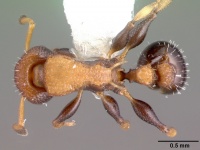Nesomyrmex pittieri
| Nesomyrmex pittieri | |
|---|---|

| |
| Scientific classification | |
| Kingdom: | Animalia |
| Phylum: | Arthropoda |
| Class: | Insecta |
| Order: | Hymenoptera |
| Family: | Formicidae |
| Subfamily: | Myrmicinae |
| Tribe: | Crematogastrini |
| Genus: | Nesomyrmex |
| Species: | N. pittieri |
| Binomial name | |
| Nesomyrmex pittieri (Forel, 1899) | |
Arredondo & Guerrero (2025) collected this species by manual sampling on vegetation in Parque Nacional Natural Tuparro, Colombia.
Photo Gallery
Identification
Arredondo & Guerrero (2025) -This species is recognized by the following characters:
- wide and deep foveae on the dorsal surface of the head
- antennal scapes curved at their base
- propodeal spines as long as the distance between their tips
The only specimen examined shows variation in coloration with respect to specimens from other forest types in Colombia (unpublished data). Populations found in premontane forest show bicoloration, with variations between reddish brown to dark. The sculpture of the frontal area is consistent in all populations (Fig. 24).
Keys including this Species
Distribution
Latitudinal Distribution Pattern
Latitudinal Range: 18.447822° to 2.95°.
| North Temperate |
North Subtropical |
Tropical | South Subtropical |
South Temperate |
- Source: AntMaps
Distribution based on Regional Taxon Lists
Neotropical Region: Costa Rica (type locality), Guatemala, Honduras, Mexico, Nicaragua, Panama.
Distribution based on AntMaps
Distribution based on AntWeb specimens
Check data from AntWeb
Countries Occupied
| Number of countries occupied by this species based on AntWiki Regional Taxon Lists. In general, fewer countries occupied indicates a narrower range, while more countries indicates a more widespread species. |

|
Estimated Abundance
| Relative abundance based on number of AntMaps records per species (this species within the purple bar). Fewer records (to the left) indicates a less abundant/encountered species while more records (to the right) indicates more abundant/encountered species. |

|
Biology
Castes
Nomenclature
The following information is derived from Barry Bolton's Online Catalogue of the Ants of the World.
- pittieri. Leptothorax pittieri Forel, 1899c: 56 (w.) COSTA RICA. Kempf, 1959c: 411 (q.). Combination in L. (Goniothorax): Emery, 1924d: 250; in L. (Nesomyrmex): Kempf, 1959c: 411; in Nesomyrmex: Bolton, 2003: 272.
Description
References
- Arredondo, B.S., Guerrero, R.J. 2025. The ant genus Nesomyrmex Wheeler (Formicidae, Myrmicinae) from the threatened Colombian tropical dry forest: three new species, a new synonymy, and new distributional data. ZooKeys 1232, 131–172 (doi:10.3897/zookeys.1232.141693).
- Bolton, B. 2003. Synopsis and Classification of Formicidae. Mem. Am. Entomol. Inst. 71: 370pp (page 272, Combination in Nesomyrmex)
- Emery, C. 1924f [1922]. Hymenoptera. Fam. Formicidae. Subfam. Myrmicinae. [concl.]. Genera Insectorum 174C: 207-397 (page 250, Combination in L. (Goniothorax))
- Forel, A. 1899d. Formicidae. [part]. Biol. Cent.-Am. Hym. 3: 25-56 (page 56, worker described)
- Gamba, R.M. 2021. New locality records for ants in the coffee zone of Cundinamarca, Colombia. Dugesiana 29(1): 31-36.
- Kempf, W. W. 1959d. A synopsis of the New World species belonging to the Nesomyrmex-group of the ant genus Leptothorax Mayr (Hymenoptera: Formicidae). Stud. Entomol. (n.s.) 2: 391-432 (page 411, queen described, Combination in L. (Nesomyrmex))
References based on Global Ant Biodiversity Informatics
- Chacon de Ulloa P., S. Valdes-Rodriguez, A. Hurtado-Giraldo, and M. Cleopatra Pimienta. 2014. Arboreal ants of Gorgona National Park (Pacific of Colombia). Rev. Biol. Trop. 62(1): 277-287.
- Dattilo W. et al. 2019. MEXICO ANTS: incidence and abundance along the Nearctic-Neotropical interface. Ecology https://doi.org/10.1002/ecy.2944
- Fernandes, P.R. XXXX. Los hormigas del suelo en Mexico: Diversidad, distribucion e importancia (Hymenoptera: Formicidae).
- Fernández, F. and S. Sendoya. 2004. Lista de las hormigas neotropicales. Biota Colombiana Volume 5, Number 1.
- Kempf W. W. 1959. A synopsis of the New World species belonging to the Nesomyrmex-group of the ant genus Leptothorax Mayr (Hymenoptera: Formicidae). Studia Entomologica (n.s.)2: 391-432.
- Kempf, W.W. 1972. Catalago abreviado das formigas da regiao Neotropical (Hym. Formicidae) Studia Entomologica 15(1-4).
- Longino J. T. L., and M. G. Branstetter. 2018. The truncated bell: an enigmatic but pervasive elevational diversity pattern in Middle American ants. Ecography 41: 1-12.
- Longino J. T., J. Coddington, and R. K. Colwell. 2002. The ant fauna of a tropical rain forest: estimating species richness three different ways. Ecology 83: 689-702.
- Longino J. et al. ADMAC project. Accessed on March 24th 2017 at https://sites.google.com/site/admacsite/
- Maes, J.-M. and W.P. MacKay. 1993. Catalogo de las hormigas (Hymenoptera: Formicidae) de Nicaragua. Revista Nicaraguense de Entomologia 23.
- Philpott, S.M., P. Bichier, R. Rice, and R. Greenberg. 2007. Field testing ecological and economic benefits of coffee certification programs. Conservation Biology 21: 975-985.
- Vásquez-Bolaños M. 2011. Lista de especies de hormigas (Hymenoptera: Formicidae) para México. Dugesiana 18: 95-133



